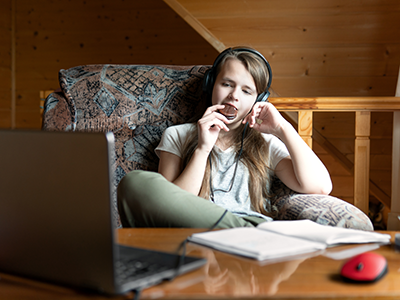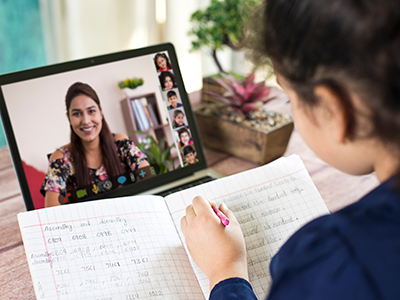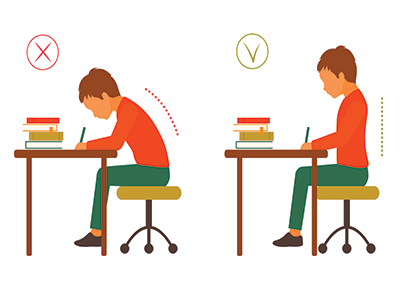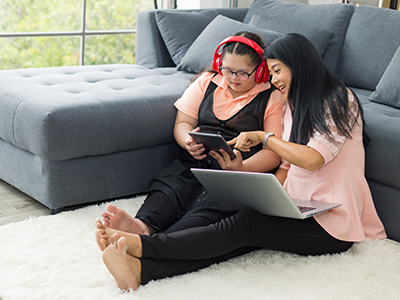If your child is one of the millions who returned to school virtually this fall, you’ve probably already set up a desk or work area for them. But did you know that with a few simple changes you can make that space into a comfortable, ergonomically sound environment that will help them concentrate, be productive and avoid aches and pains? To help you with this project, we’ve compiled a list of online learning ergonomics dos and don’ts.
Online learning ergonomics dos
- Create a designated area for learning. It’s important to have distinct locations for different activities like eating, sleeping and learning. If possible, also create a “quiet corner” where your child can go to relax or decompress when they get overwhelmed.
- Use the 90-90-90 rule when setting up your child’s desk. There should be 90-degree angles at your child’s ankles, knees and hips when they’re sitting at their desk. If the desk is too high, your child’s elbows will be up and out to sides. If it’s too low, your child will slump in their chair or rest their head on their hand. Feel free to use pillows, books or stools to help your child achieve the correct angles. For example, if their feet don’t reach the floor, use a foot stool or books to support their feet; if they can’t rest their back in the chair while bending their knees at a 90-degree angle, add a pillow behind them.
- Position your child’s laptop so the screen is at eye level. If your child is small, try placing the laptop on a binder to make the keyboard lower and the screen higher. You can also open the laptop wider to angle the keyboard down for easier accessibility.
- Allow your child to work in a variety of positions. In addition to being seated at their desk, let your child stand at a countertop/standing desk or lie on the floor or bed propped on their elbows for a while. You can even tape some paper to the wall or a window for handwriting practice. Therapy/yoga balls are also a great alternative to chairs because they allow kids to move/bounce around during class, while keeping them alert and getting rid of excess energy.
- Schedule frequent breaks throughout the day. The opportunity to move will help your child calm down and keep them focused during classes. Find out when your child’s breaks are during the day and take advantage of them by doing stimulating activities like going for walks around the neighborhood, having a dance party or doing yoga.
- Use timers or smart speakers to let everyone know when its break time or learning/work time.
- Offer your kids healthy snacks that will keep them alert. Crunchy foods like apples, carrots and pretzel sticks are stimulating and will help keep kids stimulated. Sour foods and mints are great too!
- Create a sensory toolbox and keep it near your child’s laptop. Grab an old shoebox and let your child decorate it. Then fill it with different types of fidgets, mints, paper clips, playdough and other sensory items they can grab and fidget with during class.
- Keep a water bottle in your child’s workspace. Having water nearby will prevent your child from getting up when they’re thirsty and help them keep their focus.
- Create a morning routine and stick to it. Keeping the same morning schedule of getting dressed, brushing teeth, having breakfast and going to their work area will help kids feel more organized and prepared to take on the day.
Online learning ergonomics don’ts
- Don’t put your child’s workspace in a room where there are lots of people or distractions.
- Don’t let your child keep tons of snacks in their learning area.
- Don’t let your child use the TV, phone, tablet or any other device during school.
- Don’t let your child drink caffeine.
 https://riseandshine.childrensnational.org/wp-content/uploads/2024/12/school-nurse-feature.jpg
300
400
Danielle Robbins
https://riseandshine.childrensnational.org/wp-content/uploads/2017/11/childrens_riseandshine_logo.jpg
Danielle Robbins2024-12-24 11:28:462025-06-24 13:35:39Advice from the school nurse: Health tips every parent needs to know
https://riseandshine.childrensnational.org/wp-content/uploads/2024/12/school-nurse-feature.jpg
300
400
Danielle Robbins
https://riseandshine.childrensnational.org/wp-content/uploads/2017/11/childrens_riseandshine_logo.jpg
Danielle Robbins2024-12-24 11:28:462025-06-24 13:35:39Advice from the school nurse: Health tips every parent needs to know























Leave a Comment
Want to join the discussion?Feel free to contribute!